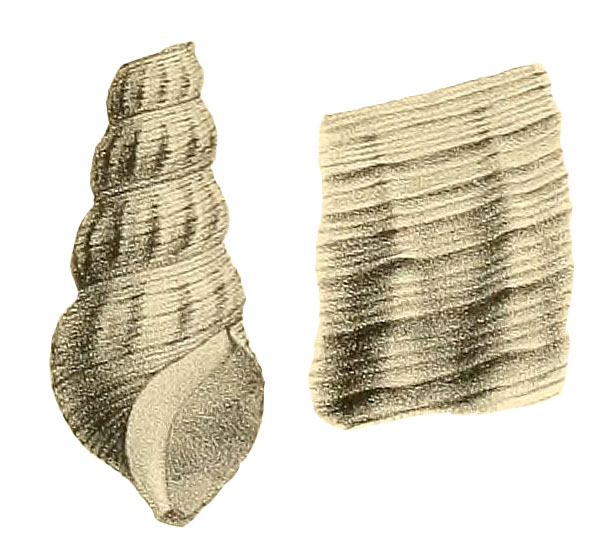|
edit SideBar
|
Stromboidea
Original Description of Scalaria texana by Roemer, 1852, p. 39:
- "Testa elongato-turrita, anfractibus 7-8 composita, longitudinaliter costata, et transversim elevato-lineata; anfractibus convexis, ad suturam depressis. Costis seu varicibus longitudinalibus parum elevatis, rotundatis, suturam non attingentibus, 10 in quoque anfractu; lineis elevatis transversis numerosis subregularibus, circa 6 fortioribus et ternis vel binis tenuissimis interjectis; apertura ovali."
- "Das Gehäuse verlängert, thurmförmig, aus 7 bis 8 Umgängen bestehend, der Länge nach gerippt und mit erhabenen Querlinien bedeckt. Die Umgänge stark gewölbt, aber in der Nähe der Sutur flach neidergedrückt. Die Längsrippen oder Längswülste nicht sehr vertretend, flach gerundet, vor Erreichung der Sutur verschwindend, 10 auf jedem Umgangw. Die erhabenen Querlinien, welche auch über die Längswülste und deren Zwischenräume fortziehen, zahlreich, fast regelmäßig von verschiedener Stärke, zwischen je zwei stärkeren 2 bis 3 sehr feine; die Oeffnung oval.
Locus typicus: "Am Wasserfalle der Guadalupe unterhalb Neu-Braunfels nicht selten." New Braunfels, Texas, USA
Stratum typicum: Austin chalk, Santonian/Coniacian, Upper Cretaceous (Stephenson, 1940)
Scalaria texana Roemer, 1852, pl. IV, fig. 11a, b
History and Synonymy
1869
Gabb, 1876, p. 298:
- "Stoliczka says he examined, in the museum in Bonn, the original of Scalaria Texana, "and found that it was based upon an imperfect specimen of an Aporrhais." On re-examining my own specimen of the species I see nothing incompatible with its belonging to the genus Anchura, a view which is sustained by Roemer's figure, and doubtless Dr. Stoliczka found some remains of the expanded lip, or of the terminal ascending suture line. He did not understand the genus Anchura, restricting it to those species in which the outer lip bears two points, one posterior, the other running parallel with the canal. As I have shown elsewhere the genus cannot be so restricted, and there are not even valid grounds for retaining Meek's Drepanochilus as a subgeneric division. Stoliczka called two species of Anchura by the name of Aporrhais, and, therefore, I am satisfied that he meant this same group. The long, slender spire of the species in question is very like many species of Anchura, but is wholly incompatible with Aporrhais."
References
- Gabb (1876)
- Roemer, F. 1852. Die Kreidebildungen von Texas und ihre organischen Einschlüsse; Mit einem die Beschreibung von Versteinerungen aus paläozoischen und tertiären Schichten enthaltenden Anhange; Adolph Marcus, Bonn; I-VI, 1-95, pls. I-XI, Fulltext
- Stephenson, L.W. 1940 [1936]. Stratigraphic relations of the Austin, Taylor, and equivalent formations in Texas; in Shorter Contributions to general Geology, United States Government Printing Office, Washington, USGS Professional Paper 186, 133-146.
|

